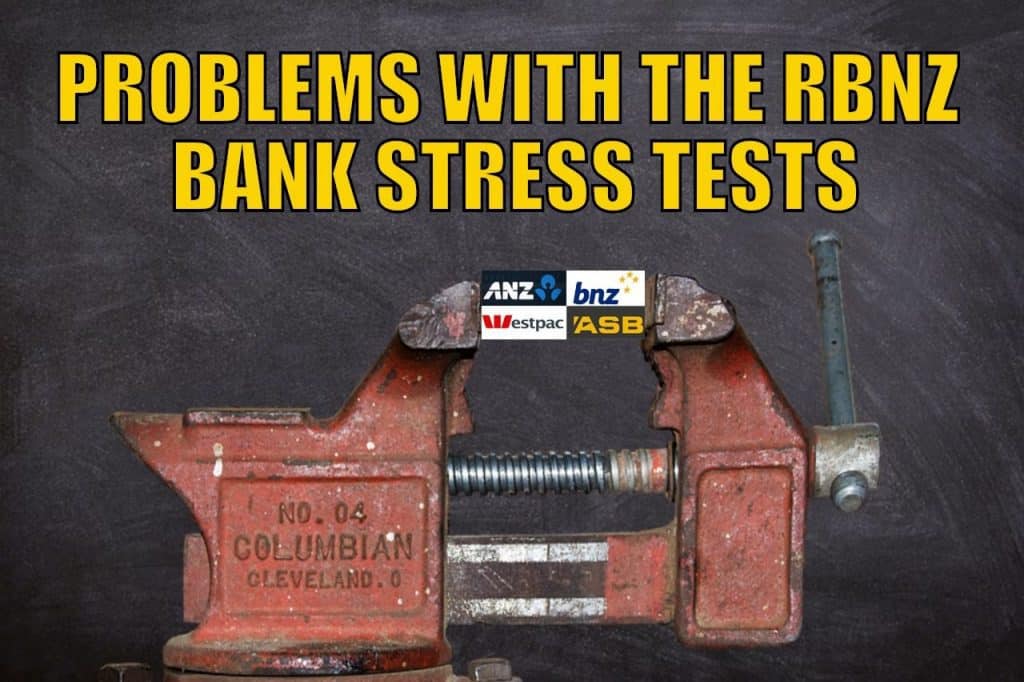The RBNZ has just released the latest results from the bank stress tests of the 4 major New Zealand banks. How helpful will these be to the New Zealand public?
The Reserve Bank of New Zealand recently launched its Bank Financial Strength Dashboard with a view to helping consumers monitor the strength of their bank. There were some shortcomings with the dashboard we believe. See: RBNZ Bank Financial Strength Dashboard: How Helpful is it?
The RBNZ has now released the results of its New Zealand Bank stress tests, with the aim of also informing consumers how strong New Zealand banks are.
What is a Bank Stress Test?
“Stress testing is a tool to assess how banks might cope with a severe economic downturn. This video explains how stress tests work and why the Reserve Bank of New Zealand uses them in its role as prudential regulator.”
The RBNZ video below gives a simple run down.
This most recent stress test of the four largest New Zealand banks, covered a severe macroeconomic downturn scenario, and an operational risk event related to mortgage lending misconduct.
The first scenario was:
“a downturn in the Chinese economy spreads through trade channels to other emerging markets, with flow-on effects to other parts of the global economy, including Europe and Japan. A collapse in demand for commodity exports and negative investor sentiment towards the Australian and New Zealand economies triggers domestic recessions and the temporary closure of offshore funding markets for banks. New Zealand’s unemployment rate quickly rises, house prices fall 35 percent, and the Fonterra dairy payout remains below $5/kgMS for three years. The scenario assumes that macroeconomic conditions begin to improve by the fourth year, though property prices do not recover. Banks receive a two notch credit rating downgrade, and face elevated funding costs in both wholesale and retail deposit markets.”
In Scenario two:
“ the macroeconomic conditions described above were overlaid with an operational risk scenario, exploring the implications of an industry-wide misconduct event related to residential mortgages. Operational risk has become more prominent in overseas regulators’ stress tests, and is an area not previously explored in detail in Reserve Bank tests. The inclusion of an operational risk event partly offsets the slightly less severe macroeconomic scenario in the 2017 test, when compared to the Reserve Bank’s 2014 stress test.”
RBNZ Stress Test Conclusion
The RBNZ’s conclusion from the bank stress tests were:
“Outcomes from the test suggest that the four banks would be able to maintain capital levels above their minimum requirements during these scenarios. Repricing actions to maintain relatively stable net interest income and low operating expenses mean that these banks would be able to offset large losses on their credit portfolios and from the misconduct event with their underlying earnings. There are, however, uncertainties around the magnitude of losses banks may face in a real downturn scenario, and the extent to which banks would be able to restore their interest margins. As a result, the outcomes remain sensitive to the modelling assumptions used in the test.”
What Are Some Problems with the RBNZ Bank Stress Tests?
It seems to us that there are some limitations with the RBNZ stress tests.

No Individual Bank Results
Firstly, the RBNZ doesn’t publish individual bank results, just a summary.
The stress tests results are an aggregation of the individual banks. Therefore consumers cannot see what the results are for their particular bank.
Four-Eyes Principle
As Martin Lubberink points out in this article there is the problem of the “four-eyes” principle. This is based upon the idea of double marking exam papers. Both markers know someone else is marking the papers. Therefore they are lax in their efforts expecting the other party to pick up their mistakes. Result: The primary marker doesn’t try too hard knowing someone else is checking. But the second marker also doesn’t try too hard expecting the first will have done a good job!
The same principle exists with the RBNZ stress tests.
They only publish a summary of stress test results. Not the individual bank results.
Therefore, if the RBNZ has more information than the public (which it does), then the four-eyes principle says the public will expect the RBNZ to spot any problems. Therefore the public will not pay too much attention to the performance of their bank.
No Interest and Therefore No Publicity in the Tests
There is virtually no interest in the bank stress tests. This is evidenced by the complete lack of media coverage.
Google “rbnz bank stress tests news” and all you get are links to the RBNZ website and a RBNZ press release on the scoop website.
None of the major media establishments have even covered the latest results. Compare that to a search for “the block nz news”! People have more interest in a few wannabe celebs doing up overpriced Auckland property than knowing how safe or otherwise their savings are.
The Stress Applied May Not Be Enough
The scenario modelled was an external shock scenario where the New Zealand banks offshore funding was temporarily closed for a period of 6 months.
To us at least, this would seem to be the biggest risk Kiwi banks would face. Were a worse than 2008 financial crisis to hit, we may see more than just the temporary closure of offshore funding. Instead a scenario may result where no one will lend to each other as they don’t know who to trust. Resulting in a complete freezing up of money markets and loans being called in early.
This is a much different scenario to just a recession, rising unemployment and house prices falling 35% that were modelled.
What to Do?
While this could change in the future, for now it’s hard to do without a bank account.
So if you can’t be 100% sure of the strength of a bank what do you do.
We spelled it out in details last week…
Ensure you have some financial insurance in the form of physical gold or silver bullion. (We don’t mean life insurance but rather physical gold and silver. See: Why Gold Bullion is Your Financial Insurance.)
This should help offset any losses you may experience in a bank failure. Because gold and silver are the only financial assets that have no counter-party risk. That is unlike deposits in a bank, gold and silver are not at the same time someone else’s liability.
You can buy gold or buy silver here today.
Read more: Should I Buy Gold or Silver? 7 Factors to Consider in Gold vs Silver


Pingback: Bank Capital Changes: What is the RBNZ Preparing For? - Gold Survival Guide